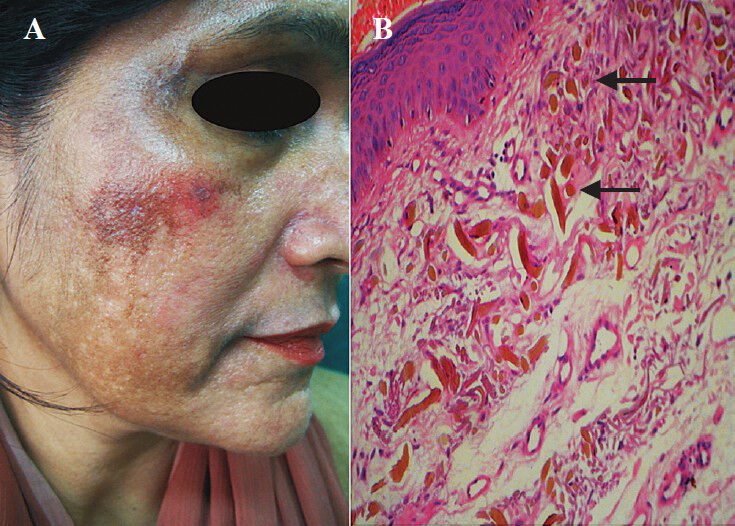Translate this page into:
Exogenous ochronosis
+For correspondence: avninders@hotmail.com
This is an open-access article distributed under the terms of the Creative Commons Attribution-Noncommercial-Share Alike 3.0 Unported, which permits unrestricted use, distribution, and reproduction in any medium, provided the original work is properly cited.
This article was originally published by Medknow Publications & Media Pvt Ltd and was migrated to Scientific Scholar after the change of Publisher.
A 44 yr old woman presented to the Dermatology department of Safdarjung Hospital at New Delhi, India, in June 2010 with pigmentation on her face for many years. She had been applying skin-lightening cream for the last one year recommended by her general practitioner treating her melasma. There was no family history of such pigmentation. She had bilateral macular erythema and spotty bluish-black pigmentation on her cheeks, nasolabial folds and the temporal region (Fig. A). Her urine did not become dark on standing. A punch biopsy from the pigmented area showed elongated and globular deposits of golden-yellow or ocher coloured pigment admixed with dermal collagen (Fig. B). A clinical diagnosis of exogenous ochronosis (EO) was made. She was advised to stop using skin lightening cream and apply 0.05 per cent retinoic acid ointment and use sunscreen. After three months, there was no significant improvement in her pigmentation.

-
A. Bluish-black spotty pigmentation on face B. Skin biopsy showing ocher coloured fibers in the dermis (arrow) (H & E, × 100).
Ochronosis is caused by accumulation of homogentisic acid in the connective tissues, and is of two types: endogenous ochronosis or alkaptonuria that is an inherited disease and EO caused by prolonged topical therapy with hydroquinone (HQ). The skin appears bluish-black while microscopically it shows ocher-coloured pigment deposition in the tissues. Steroids, retinoic acid along with photoprevention may be beneficial in some. A recent report has demonstrated reduction in dyschromia of EO with Quality-switched 1064 nm Nd YAG laser1. As EO is a cosmetically disfiguring and psychologically debilitating disease, early diagnosis, proper follow up and timely interruption of HQ application should be the objective.
Reference
- Effect of combination of 1064 nm Q-switched Nd: YAG laser and fractional carbon dioxide lasers for treating exogenous ochronosis. J Cosmet Laser Ther. 2013;15:42-5.
- [Google Scholar]





